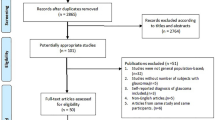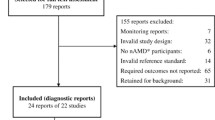Abstract
The overall diagnostic capabilities and utility of frequency-doubling technology (FDT) in patients with primary glaucoma, which was diagnosed by standard automated perimetry (SAP) and/or optic disc appearance as the gold standard, were assessed. A comprehensive electric retrieval in MEDLINE, EMBASE, Cochrane Library, BIOSIS, Previews, HMIC, IPA, OVID, CNKI, CBMdisc, VIP information, CMCC, CCPD, SSreader, 21dmedia and manual retrieval in related textbooks, journals, congress articles and their references at home and abroad were performed to identify relevant articles in English or Chinese. The corresponding references were retrieved by means of electric retrieval and manual retrieval from different databases or materials. Criteria for inclusion or exclusion were established according to validity criteria for diagnostic studies published by the Cochrane Methods Group on Screening and Diagnostic Tests. The quality of the included articles was then assessed and characteristics were extracted. Statistical analysis was performed with Meta Test version 0.6 software to test the heterogeneity of the included articles. The appropriate effects model was selected to calculate pooled weighted sensitivity and specificity. Summary receiver operating characteristic (SROC) curve was drawn and the area under the curve (AUC) was calculated. Finally, sensitivity analysis was performed. Twenty-one studies out of 206 retrieved articles were included, with a total of 3172 patients. The reported sensitivity of FDT ranged from 0.51 to 1.00, and specificity from 0.58 to 1.00. The pooled weighted sensitivity and specificity of FDT with 95% confidence intervals (95% CI) after correction for standard error were 0.86 (0.80–0.90) and 0.87 (0.81–0.91), respectively. The AUC of SROC was 93.01%. Sensitivity analysis demonstrated no disproportionate influences of individual studies. The included articles are of good quality and FDT can be a highly efficient diagnostic test for primary glaucom a based on Meta-analysis.
Similar content being viewed by others
References
Kelly D H. Diffusion model of linear flicker responses. J Opt Soc Am, 1969, 59(12): 665–670
Muskens R P, Heeg G P, Jansonius N M. An evaluation of algorithms designed to classify the results from frequency doubling perimetry. Ophthalmic Physiol Opt, 2004, 24(6): 498–503
Stoutenbeek R, Heeg G P, Jansonius N M. Frequency doubling perimetry screening mode compared to the full-threshold mode. Ophthalmic Physiol Opt, 2004, 24(6): 493–497
Chandrasekhar G, Kunjam V, Rao V S, Nutheti R. Humphrey visual field and frequency doubling perimetry in the diagnosis of early glaucoma. Indian J Ophthalmol, 2003, 51(1): 35–38
Bayer A U, Erb C. Short wavelength automated perimetry, frequency doubling technology perimetry, and pattern electroretinography for prediction of progressive glaucomatous standard visual field defects. Ophthalmology, 2002, 109(5): 1009–1017
Thomas R, Bhat S, Muliyil J P, Parikh R, George R. Frequency doubling perimetry in glaucoma. J Glaucoma, 2002, 11(5): 46–50
Bowd C, Zangwill L M, Berry C C, Blumenthal E Z, Vasile C, Sanchez-Galeana C, Bosworth C F, Sample P A, Weinreb R N. Detecting early glaucoma by assessment of retinal nerve fiber layer thickness and visual function. Invest Ophthalmol Vis Sci, 2001, 42(9): 1993–2003
Andrada M T, Bemaldo De Quiros P, Villegas R S, Anton A. Diagnostic accuracy of frequency doubling perimetry. Arch Soc Esp Oftalmol, 2001, 76(12): 711–718
Thomas D, Thomas R, Muliyil J P, George R. Role of frequency doubling perimetry in detecting neuro-ophthalmic visual field defects. Am J Ophthalmol, 2001, 131(6): 734–741
Casson R, James B, Rubinstein A, Ali H. Clinical comparison of frequency doubling technology perimetry and Humphrey perimetry. Br J Ophthalmol, 2001, 85(3): 360–362
Sample P A, Bosworth C F, Blumenthal E Z, Girkin C, Weinreb R N. Visual function-specific perimetry for indirect comparison of different ganglion cell populations in glaucoma. Invest Ophthalmol Vis Sci, 2000, 41(7): 1783–1790
Trible J R, Schultz R O, Robinson J C, Rothe T L. Accuracy of glaucoma detection with frequency-doubling perimetry. Am J Ophthalmol, 2000, 129(6): 740–745
Fabre K, Michiels I, Zeyen T. The sensitivity and specificity of TOP, FDP and GDx in screening for early glaucoma. Bull Soc Belge Ophthalmol, 2000, 275: 17–23
Cello K E, Nelson-Quigg J M, Johnson C A. Frequency doubling technology perimetry for detection of glaucomatous visual field loss. Am J Ophthalmol, 2000, 129(3): 314–322
Yamada N, Chen PP, Mills RP, Leen M M, Lieberman M F, Stamper R L, Stanford D C. Screening for glaucoma with frequency-doubling technology and Damato campimetry. Arch Ophthalmol, 1999, 117(11): 1479–1484
Wu T X, Liu G J. Introduction of Bayes Library and Meta-analysis of diagnostic trials. Chin JEBM, 2002, 2: 182–186
Liu G J, Wu T X. Introduction of SROC method-Meta-analysis of diagnostic trials. Chin J EBM, 2003, 1: 41–44
Moses L E, Shapiro D, Littenberg B. Combining independent studies of a diagnostic test into a summary ROC curve: data analytic approaches and some additional considerations. Stat Med, 1993, 12(14): 1293–1316
Deeks J J. Systematic reviews in healthcare: Systematic reviews of evaluations of diagnostic and screening tests. BMJ, 2001, 323(7305): 157–162
Wall M, Neahring R K, Woodward K R. Sensitivity and specificity of frequency doubling perimetry in neuro-ophthalmic disorders: a comparison with conventional automated perimetry. Invest Ophthalmol Vis Sci, 2002, 43(4): 1277–1283
Author information
Authors and Affiliations
Corresponding author
Additional information
Translated from Chin J Ophthalmol, 2006, 42(5): 403–408 [译自: 中华眼科杂志]
Rights and permissions
About this article
Cite this article
Liu, T., He, X. Meta-analysis of the diagnostic efficiency of frequency-doubling technology for primary glaucoma. Front. Med. China 1, 109–114 (2007). https://doi.org/10.1007/s11684-007-0021-7
Published:
Issue Date:
DOI: https://doi.org/10.1007/s11684-007-0021-7




